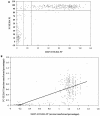Detection by two enzyme-linked immunosorbent assays of antibodies to Ehrlichia ruminantium in field sera collected from sheep and cattle in Ghana
- PMID: 12965927
- PMCID: PMC193896
- DOI: 10.1128/cdli.10.5.917-925.2003
Detection by two enzyme-linked immunosorbent assays of antibodies to Ehrlichia ruminantium in field sera collected from sheep and cattle in Ghana
Abstract
Two serological tests for detection of antibodies to Ehrlichia (previously Cowdria) ruminantium, the causative agent of heartwater, were compared by using field sera collected from sheep and cattle as part of serosurveys in Ghana. Sera selected as either negative or positive by a new polyclonal competitive enzyme-linked immunosorbent assay (PC-ELISA) were tested by the indirect MAP1-B ELISA. Cutoff values of 14 percent positivity (14 PP) for both ruminant species were obtained for the MAP1-B ELISA by using preseroconversion Ghanaian sera and were compared with previously recommended cutoff values of 29 PP for sheep and 38 PP for cattle. With the 14-PP cutoff, of 151 sheep sera which tested negative by PC-ELISA, 89% were also negative by MAP1-B ELISA, while of 419 sheep sera positive by PC-ELISA, 98% were also positive by MAP1-B ELISA. Of 261 bovine sera negative by PC-ELISA, 82% were also negative by MAP1-B ELISA. Of 511 bovine sera positive by PC-ELISA, only 47% were positive by MAP1-B ELISA; these included 168 sera collected from cattle following first seroconversion as detected by both tests, with 125 of these sera positive by PC-ELISA but only 59 and 5 positive by MAP1-B ELISA with the 14- and 38-PP cutoff levels, respectively. These results indicate that both assays are highly sensitive and specific for detection of E. ruminantium exposure in sheep but that the MAP1-B ELISA lacks sensitivity for postseroconversion bovine sera in comparison to the PC-ELISA. Both tests confirm E. ruminantium seroprevalence of at least 70% in Ghanaian sheep; levels of exposure among Amblyomma variegatum-infested Ghanaian cattle are likely to be higher than the seroprevalence value of 66% obtained with the PC-ELISA.
Figures





Similar articles
-
Ehrlichia ruminantium seroprevalence in domestic ruminants in Ghana; I. Longitudinal survey in the Greater Accra Region.Vet Microbiol. 2004 Jun 3;100(3-4):175-88. doi: 10.1016/j.vetmic.2004.02.010. Vet Microbiol. 2004. PMID: 15145496
-
Use of a specific immunogenic region on the Cowdria ruminantium MAP1 protein in a serological assay.J Clin Microbiol. 1995 Sep;33(9):2405-10. doi: 10.1128/jcm.33.9.2405-2410.1995. J Clin Microbiol. 1995. PMID: 7494037 Free PMC article.
-
Ehrlichia ruminantium seroprevalence in domestic ruminants in Ghana. II. Point prevalence survey.Vet Microbiol. 2004 Nov 15;103(3-4):183-93. doi: 10.1016/j.vetmic.2004.02.017. Vet Microbiol. 2004. PMID: 15504589
-
Review of the molecular biology of Cowdria ruminantium.Vet Parasitol. 1995 Mar;57(1-3):51-6. doi: 10.1016/0304-4017(94)03109-a. Vet Parasitol. 1995. PMID: 7597792 Review.
-
Progress and priorities in research on heartwater.Ann N Y Acad Sci. 1996 Jul 23;791:1-16. doi: 10.1111/j.1749-6632.1996.tb53506.x. Ann N Y Acad Sci. 1996. PMID: 8784481 Review. No abstract available.
Cited by
-
Tick-Borne Diseases of Humans and Animals in West Africa.Pathogens. 2023 Oct 24;12(11):1276. doi: 10.3390/pathogens12111276. Pathogens. 2023. PMID: 38003741 Free PMC article. Review.
-
Longitudinal monitoring of Ehrlichia ruminantium infection in Gambian lambs and kids by pCS20 PCR and MAP1-B ELISA.BMC Infect Dis. 2007 Jul 27;7:85. doi: 10.1186/1471-2334-7-85. BMC Infect Dis. 2007. PMID: 17662144 Free PMC article.
-
Detection of Antibodies to Ehrlichia spp. in Dromedary Camels and Co-Grazing Sheep in Northern Kenya Using an Ehrlichia ruminantium Polyclonal Competitive ELISA.Microorganisms. 2022 Apr 27;10(5):916. doi: 10.3390/microorganisms10050916. Microorganisms. 2022. PMID: 35630361 Free PMC article.
-
Point seroprevalence survey of Ehrlichia ruminantium infection in small ruminants in The Gambia.Clin Diagn Lab Immunol. 2005 Apr;12(4):508-12. doi: 10.1128/CDLI.12.4.508-512.2005. Clin Diagn Lab Immunol. 2005. PMID: 15817758 Free PMC article.
-
Identification of 19 polymorphic major outer membrane protein genes and their immunogenic peptides in Ehrlichia ewingii for use in a serodiagnostic assay.Clin Vaccine Immunol. 2008 Mar;15(3):402-11. doi: 10.1128/CVI.00366-07. Epub 2007 Dec 19. Clin Vaccine Immunol. 2008. PMID: 18094116 Free PMC article.
References
-
- Aklaku, I. K. 1980. Principal causes of mortality in small ruminants in Ghana. Bull. Off. Int. Epizoot. 92:1227-1231.
-
- Aning, K. G. 1982. Heartwater disease in sheep and goats in Ghana: its distribution, incidence and control, p. 23-28. In Proceedings of the 13th Ghana Animal Science Symposium. University of Science and Technology, Kumasi, Ghana.
-
- Anonymous. 1933. Annual report of the Veterinary Department, Gold Coast Colony. The Government Printer, Accra, Ghana.
-
- Bell-Sakyi, L., E. B. M. Koney, O. Dogbey, and K. J. Sumption. 1996. Heartwater in Ghana: implications for control of ticks. Trop. Anim. Health Prod. 28:59S-64S. - PubMed
-
- Bell-Sakyi, L., E. B. M. Koney, O. Dogbey, J. A. Abbam, and K. G. Aning. 1997. Isolation and in vitro cultivation in Ghana of Cowdria ruminantium, the causative agent of heartwater, p. 46-51. In E. B. M. Koney and K. G. Aning (ed.), Proceedings of the 22nd Annual Conference of the Ghana Veterinary Medical Association. Ministry of Food and Agriculture, Accra, Ghana.
Publication types
MeSH terms
Substances
LinkOut - more resources
Full Text Sources
Miscellaneous

